
The Our Lady of Help is a statue located in Busto Arsizio. It is in the church of Santa Maria di Piazza, Busto Arsizio and it is attributed to Fabrizio De Magistris, designed in 1602, after the Madonna appeared during a plague outbreak in 1576. [1]

The Our Lady of Help is a statue located in Busto Arsizio. It is in the church of Santa Maria di Piazza, Busto Arsizio and it is attributed to Fabrizio De Magistris, designed in 1602, after the Madonna appeared during a plague outbreak in 1576. [1]
During the plague, a procession was organized to carry the statue of the Madonna venerated in the church of Santa Maria di Piazza through all the streets of the village.
According to tradition, the depiction of the Madonna, which until then was represented with her right hand on her lap and her left hand holding the Child Jesus, changed its appearance after the unceasing prayers of the Bustocchi. It is said that one morning the image of Our Lady would raise her right arm, showing the palm of her hand, as if she wanted to stop the plague epidemic. It is since then that the Madonna venerated in Busto Arsizio is referred to as Our Lady of Help and is depicted with her left hand engaged in holding the baby Jesus and her right hand raised to stop the plague. As a result, the church of Santa Maria di Piazza became the Sanctuary of Santa Maria di Piazza, as this miracle is said to have occurred inside it. [2]
The devotion to the Blessed Virgin and to the saints resulted in the vow of the entire community, religious and civil, to go on an annual pilgrimage to the Madonna del Monte on St. George's Day, April 24, and to pay homage together to the body of the Beata Giuliana di Busto. February 15 1631 was the day of the cessation of restrictions on the freedom of territory, while on February 26 a procession was organized to give thanks to Our Lady of Help.
In Montevideo, Uruguay, in the neighborhood of Villa del Cerro, a statue of Our Lady of Help quite similar to the one in Busto Arsizio is venerated under the name of Santa Maria de la Ayuda.
According to research done by Luigi Giavini, in 1893 a certain Marco Stoppa, a native of Canton Ticino who had emigrated to Uruguay had a statuette depicting Our Lady of Help sent to him with a copy of Leo XIII's papal document pertaining to the coronation of Our Lady of Help of Busto Arsizio and countersigned by Monsignor Giuseppe Tettamanti to attest to the authenticity of the title attributed to the Madonna. When Stoppa returned to Italy, he entrusted the statuette, which had already entered popular devotion in Montevideo, to Guido Branda and his wife Teodora Monnero Gandolfi, originally from Acqui Terme and emigrated to South America around 1910, who in 1913, during a brief stay in Italy, passed through Busto Arsizio to retrieve a larger statue of the Madonna. This statue was placed in a small chapel built by Branda themselves, which received visits from pilgrims from all over Uruguay and even Argentina, as rumors had spread that Stoppa's little statue had performed several miracles. [3]
The church authorities in Montevideo, after several pressures on the Branda family, decided to introduce an image of Our Lady of Help into the pre-existing parish of Our Lady of Arantzazu. When, in the 1920s, the parish passed from the secular clergy to the monks Capuchin, they decided to place a lavish statue of Our Lady of Help in the church. The rector of the sanctuary of Busto Arsizio was then asked for a copy of the statue present in that church. This copy was made in the form of a painting by Friar Augustine of Pavia and was exhibited for some time in the church of St. Anthony in Montevideo, and then transported to the Cerro where on February 10 it was blessed by John Francis Aragon, Archbishop of Montevideo. [4]
On May 11, 1930, a wooden statue of Our Lady of Help, made by Tyrolean sculptor Stuffeser, was crowned, also placed in the parish of Santa María de la Ayuda in Montevideo's Cerro neighborhood. [5]
Devotion to Our Lady of Help spread and many other chapels sprang up in Uruguay, including a shrine in Santa Rosa, in the Department of Canelones. [6]

Our Lady of Help is much depicted in Busto Arsizio. The most important of these depictions is the wooden polychrome statue made by the sculptor Fabrizio De Magistris that is located inside the Santa Maria di Piazza; it is the statue that was carried in procession through the village on April 28, 1630 to invoke the end of the plague and that, according to tradition, raised her right hand to stop the disease.
This depiction has since been reproduced in numerous statues and paintings.
At the main entry points of Busto Arsizio are pink granite columns surmounted by a bas-relief of Our Lady of Help, patroness of the city. In the early 2000s a small votive capital dedicated to Our Lady of Help was built in the San Giuseppe neighborhood, near the Ospedale di Circolo di Busto Arsizio, at the intersection of Sassi, Savona, Vipiteno, Giulio Bizzozero and Arnaldo da Brescia streets.
Our Lady of Help is also used as the logo of Azienda Ospedaliera Ospedale di Circolo di Busto Arsizio. [7]

The term Black Madonna or Black Virgin tends to refer to statues or paintings in Western Christendom of the Blessed Virgin Mary and the Infant Jesus, where both figures are depicted with dark skin. Examples of the Black Madonna can be found both in Catholic and Orthodox countries.
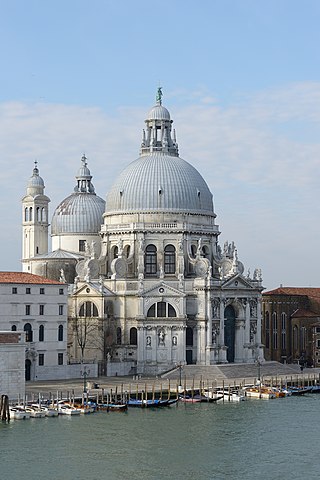
Santa Maria della Salute, commonly known simply as the Salute, is a Roman Catholic church and minor basilica located at the Punta della Dogana in the Dorsoduro sestiere of the city of Venice, Italy.

Busto Arsizio is a comune (municipality) in the south-easternmost part of the province of Varese, in the Italian region of Lombardy, 35 kilometres (22 mi) north of Milan. The economy of Busto Arsizio is mainly based on industry and commerce. It is the fifth municipality in the region by population and the first in the province.

Santa Maria del Carmine is a church in Naples, Italy. It is at one end of Piazza Mercato, the centre of civic life in Naples for many centuries until it was cut off from the rest of the city by urban renewal in 1900. The church was founded in the 13th century by Carmelite friars driven from the Holy Land in the Crusades, presumably arriving in the Bay of Naples aboard Amalfitan ships. Some sources, however, place the original refugees from Mount Carmel as early as the eighth century. The church is still in use and the 75–metre bell tower is visible from a distance even amidst taller modern buildings.

Santa Maria in Campitelli or Santa Maria in Portico is a church dedicated to the Virgin Mary on the narrow Piazza di Campitelli in Rione Sant'Angelo, Rome, Italy. The church is served by the Clerics Regular of the Mother of God.
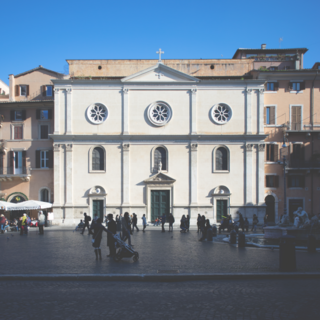
Nostra Signora del Sacro Cuore is a Catholic church dedicated to the Virgin Mary located in Rome's Piazza Navona.

Our Lady of Graces or Saint Mary of Graces is a devotion to the Virgin Mary in the Roman Catholic Church. Several churches with this dedication often owe their foundation to thankfulness for graces received from the Virgin Mary, and are particularly numerous in Italy, India, Australia, United States, Portugal, France and the Italian-speaking region of Switzerland. Also it is related to the Marian apparitions in which was revealed the Miraculous Medal, also known as the Medal of Our Lady of Graces.
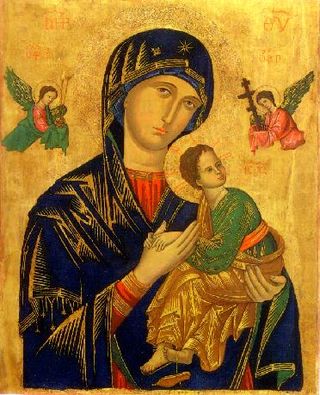
Mary has been one of the major subjects of Western art for centuries. There is an enormous quantity of Marian art in the Catholic Church, covering both devotional subjects such as the Virgin and Child and a range of narrative subjects from the Life of the Virgin, often arranged in cycles. Most medieval painters, and from the Reformation to about 1800 most from Catholic countries, have produced works, including old masters such as Michelangelo and Botticelli.

Maria Santissima dell'Udienza or Madona dell'Udienza or Our Lady of the Audience is a marble sculpture created by the Renaissance sculptor Antonello Gagini, in the early 1500s. The statue is currently housed in the apse of the Sanctuary of Our Lady of the Audience in Sambuca di Sicilia, Italy.

Our Lady of Miracles is the patron saint of the town of Alcamo.
Santa Maria della Misericordia is a Romanesque-style, Roman Catholic church located just outside the town of Monteleone di Fermo, in the province of Fermo, region of Marche, Italy.

Santa Caterina d'Alessandria or Saint Catherine of Alexandria is a Roman Catholic church with a main facade on Piazza Bellini, and a lateral Western facade facing the elaborate Fontana Pretoria, in the historic quarter of Kalsa in the city of Palermo, region of Sicily, Italy. In front of the main facade, across the piazza Bellini, rise the older churches of San Cataldo and Santa Maria dell'Ammiraglio, while across Piazza Pretoria is the Theatine church of San Giuseppe and the entrance to the Quattro Canti. Refurbished over the centuries, the church retains elements and decorations from the Renaissance, Baroque, and late-Baroque (Rococo) eras. This church is distinct from the Oratorio di Santa Caterina found in the Olivella neighborhood.
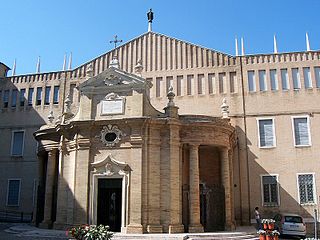
Santa Maria della Misericordia is a Renaissance-style, Roman Catholic basilica church and Marian shrine located on Piazza San Vincenzo Maria Strambi, next to the Cathedral, in the center of Macerata, region of Marche, Italy.
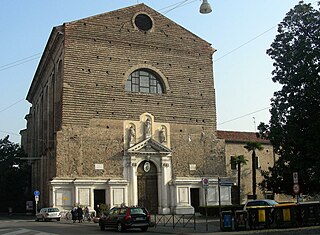
The Basilica del Carmine is a 16th-century Roman Catholic church located on piazza Francesco Petrarca in Padua, region of Veneto, Italy. It was made a minor basilica in 1960 by pope John XXIII

The Santuario di Santa Maria di Piazza is located in the historic center of Busto Arsizio, Italy, where an earlier church dedicated to the Virgin Mary stood, which in turn had replaced a chapel dating back to the time of Christianization. This Marian shrine was quickly built between 1515 and 1522.

Fabrizio De Magistris was an Italian sculptor active in Lombardy between 1595 and 1602.

The prepositural collegiate basilica of San Giovanni Battista is a Catholic church in Busto Arsizio, dedicated to one of the patron saints of the city. Like the church of San Michele Arcangelo, this building also stands on the remains of a small Lombard chapel about eight metres wide.
The history of Busto Arsizio, according to the hypotheses advanced by some historians and later re-proposed by local history scholars, would have seen its beginnings with the Ligurians. The later presence of the Romans, mentioned by many authors, is shown by the town's urban distribution.
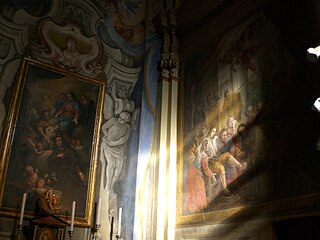
Although it has been characterized in recent centuries as an essentially industrial city, Busto Arsizio counts among its most valuable buildings the numerous monuments of an ecclesiastical nature, testifying to the deep religiosity of its people. Of particular note are the Sanctuary of Santa Maria di Piazza, the Basilica of St. John the Baptist, and the Church of San Michele Arcangelo.
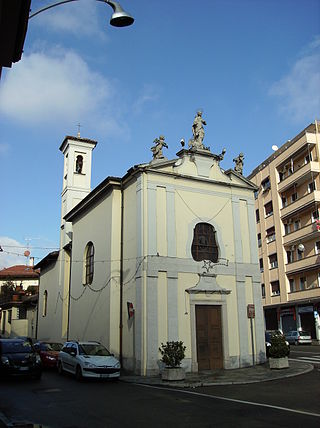
There are currently twenty-five churches in Busto Arsizio, including parish and auxiliary churches and a baptistery.